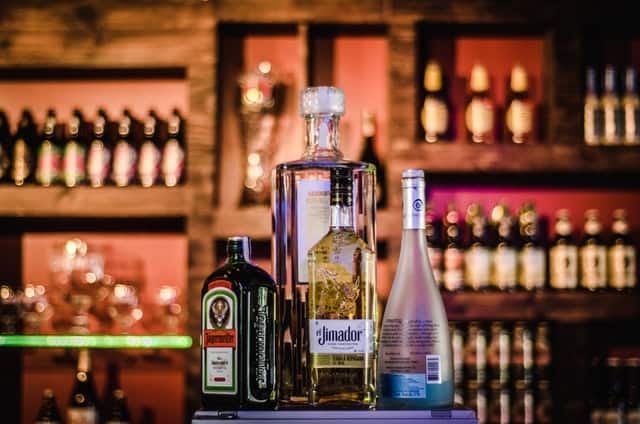The holiday season is a time when the majority of people if they were half-honest, would say that they tend to overindulge and overspend as if it’s as traditional as the turkey itself. In reality, way too much food is eaten, too much wine is drunk and too much money is spent. That pretty much sums up the average holiday season in today’s U.S. However, for others, it’s a completely different Christmas story, often written years in advance.
“Not the world, not what’s outside of us, but what we hold inside traps us. We may not be responsible for the world that created our minds, but we can take responsibility for the mind with which we create our world.” – Gabor Maté, author of “In the Realm of Hungry Ghosts: Close Encounters with Addiction”
Those in recovery, either from a substance use disorder (SUD) or an alcohol use disorder (AUD), when others are happily anticipating the holiday season, often feel a real sense of trepidation. For some of them, it’s more akin to a real fear – fear of putting on a brave face in front of their family, fear of the presence of alcohol (or even substances) on the family dining table, and fear of unresolved family conflict rearing its ugly head when most sat at that table are losing their inhibitions.  Whether you are a recovering addict or you have a loved one who is trying to recover from substance addiction, the holidays can still stir up a variety of feelings and emotions, both good and bad. The holidays can also bring up memories of those we no longer have with us as well. It is the complexities of these different thoughts that can push anyone into a fragile and wrong mindset. And the wrong mindset for a recovering addict can lead to? Well, no diagram is required for that… Relapse is a real and tangible fear for those in recovery, especially at times when emotions bordering on the extreme, again both good and bad, are commonplace, such as the annual holiday season. Going into a time like this with little preparation and little planning will only increase the chances of a relapse happening. This guide to the real challenge to recovery during the holiday season is all about your diligent preparation and planning and is loaded with professional tips to put you in the best possible mindset for the upcoming festivities and the range of emotions that such a time invariably brings.
Whether you are a recovering addict or you have a loved one who is trying to recover from substance addiction, the holidays can still stir up a variety of feelings and emotions, both good and bad. The holidays can also bring up memories of those we no longer have with us as well. It is the complexities of these different thoughts that can push anyone into a fragile and wrong mindset. And the wrong mindset for a recovering addict can lead to? Well, no diagram is required for that… Relapse is a real and tangible fear for those in recovery, especially at times when emotions bordering on the extreme, again both good and bad, are commonplace, such as the annual holiday season. Going into a time like this with little preparation and little planning will only increase the chances of a relapse happening. This guide to the real challenge to recovery during the holiday season is all about your diligent preparation and planning and is loaded with professional tips to put you in the best possible mindset for the upcoming festivities and the range of emotions that such a time invariably brings.
Beware Anxiety & Stress
The most common causes of an unwanted relapse for those currently in recovery are, like much of an addiction itself, centered squarely in the mind of those former addicts and alcoholics. An unresolved, let alone untreated, mental health condition is your worst enemy if you wish to stay firmly on the road to recovery, and the most common of these, and the one most likely to lead to a relapse, is anxiety. Yes, anxiety, and the resultant stress such anxious thoughts and emotions inevitably invoke, is easily the most dangerous of the various mental and physical conditions that can threaten a substance addiction recovery.

During the holiday season, we all experience much higher levels of both anxiety and stress than normal. The holiday season invariably brings strong memories of holiday times past, some good, some bad. These bad memories are especially threatening to a growing sobriety if they occurred when we were either too focused on getting drunk or getting high. However, there are ways and means at your disposal that can help you both overcome and conquer the anxiety and stress you may feel during the holiday season. First, however, let’s look at why anxiety can present such problems and dangers to those in recovery.
Anxiety & Anxiety Disorder
Anxiety is something we all experience during the holiday season. It’s a normal part of any normal life, and is a natural response to the stress of the season. However, it should never be left to fester, as unresolved anxiety can get significantly worse until we are left helpless in an uncontrolled anxious state. This is known as an anxiety disorder. Anxiety disorder is where sufferers are unable to overcome these strong feelings of anxiousness. They are constantly in a state of tension, which has a powerfully detrimental effect on virtually everything – their thoughts, moods, and behavior. According to the U.S. National Institute of Mental Health (NIMH), anxiety disorder is a medical term that covers a range of different, yet similar conditions, including:
- Generalized anxiety disorder (feelings of constant or excessive worry)
- Panic disorder (repeated, and often unexpected, episodes of intense fear), and
- Social anxiety disorder (fear that something awful will occur when around others)
Any of these, if left unresolved and untreated, can lead even the most resolute recovering addict dangerously close to an unwanted relapse.
Common Addiction Triggers During the Holiday Season
The holidays are infamous for an increase in anxiety, stress, and substance abuse – fact; this tends to happen for a variety of reasons (each of us has quite different circumstances, remember), but easily the most common (and all stress-related) of these are:
- Family Pressure: Family, as much as we may love them, usually aren’t too concerned with how we deal with harsh criticism, and they are usually the first to be sending it our way. For the recovering addict, this can result in heightened feelings of guilt and shame
- Social Situations: Holidays can bring many disruptions to what we see as our normal routine – this, in itself, can cause unnecessary stress, thus, increasing the risk of relapse triggers.
- Financial Cost: An obvious one, this. People see it as normal practice to spend way too much during the holiday season. For the recovering addict, this unnecessary stress is certainly not welcome.
Why All Recovering Addicts Need to Understand the Gorski-CENAPS Model for Relapse Prevention & Planning
The Gorski-CENAPS (Center of Applied Sciences) model for relapse prevention and planning was developed by Terence T. Gorski, a leading expert in the field of addiction recovery, and is a comprehensive system “for diagnosing and treating substance use disorders and coexisting mental disorders, personality disorders, and situational life problems” – in Mr. Gorski’s words. The model is based on a biopsychosocial model of addiction (meaning it looks at all the relevant biological, psychological – thoughts, emotions, and behaviors – and social factors that influence a disease or other medical condition. Gorski’s model successfully integrates addiction-specific treatment methods with cognitive, affective, behavioral, and social therapies, and has been viewed as an industry-standard for many years in the field of addiction recovery. The model is designed to decrease the risk of a subsequent relapse. The Gorski-CENAPS model is a framework of basic principles that should underlie any relapse prevention planning process. Each principle also has a brief procedure or clinical technique that recovering addicts can put into practice.

The 9 Principles of the Gorski-CENAPS Relapse Prevention Model
- 1st. Principle: Self-Regulation
This principle states that the risk of relapse decreases as the recovering addict’s ability to self-regulate thinking, feelings, memory, judgment, and behavior increases. In order for this to happen successfully, the individual requires physical, psychological, and social stabilization.
- 2nd. Principle: Integration
This principle states that the risk of relapse decreases as the individual’s level of conscious understanding of the events that led up to past relapse episodes increases. This requires a technique of self-assessment, in which the individual consciously examines the recent problems caused by a relapse, their life history, and their overall recovery and relapse history.
- 3rd. Principle: Understanding
This principle states that the risk of relapse decreases as the understanding of the thoughts, feelings, actions, and situations that lead to relapse increases. This requires a relapse education procedure, which educates the individual about addiction, the disease process, common sticking points and other factors, and relapse prevention planning.
- 4th. Principle: Self-Knowledge
This principle states that the risk of relapse decreases as the individual’s ability to identify high-risk situations that cause triggers (or relapse warning signs) increases. This principle requires a procedure called relapse warning sign identification, in which the individual identifies the sequence of problematic factors that lead from stable recovery to a return to substance abuse, and creates their own personal list of triggers.
- 5th. Principle: Coping Skills
This principle states that the risk of relapse decreases as the individual’s knowledge, and associated skill, of effective coping strategies for specific triggers increases. This principle requires a procedure called warning sign management, in which the individual identifies critical triggers, examines how they coped with these triggers previously, and develops new coping strategies for the future. The coping process focuses on the development of their own specific cognitive, affective, behavioral, and relationship skills for dealing with their personal triggers.
- 6th. Principle: Change
This principle states that the risk of relapse decreases as the relationship and correlation between recovery program recommendations and identified relapse triggers increase. This principle requires a review of the recovery plan, in which the individual develops a written recovery plan, then takes each trigger on their final and complete list of triggers, and identifies the components of the recovery plan that will help them cope with each one of these. The recovery plan is constantly modified to accommodate any warning signs that were not identified in their original plan.
- 7th. Principle: Awareness
This principle states that the risk of relapse decreases as the use of daily inventory techniques (designed to check for compliance with recovery program recommendations and the presence of relapse triggers) increases. This principle requires a procedure called inventory training, where the individual is taught specific techniques for planning each day, and then reviewing their progress and problems at the end of the day.
- 8th. Principle: Support
This principle states that the risk of relapse decreases as responsible involvement of significant others (a network of supportive others) in the relapse prevention planning process increases. This principle requires a procedure called the involvement of significant others. The individual lists the people who should be involved, and evaluates their appropriateness. Those appropriate persons are then invited to a meeting that:
-
- Discusses the individual’s triggers, and past experiences and reactions of other people to those triggers,
- Sets up a communication contract that allows open communication about future triggers should they occur, and
- Develops a relapse early intervention plan
- 9th. (and final) Principle: Maintenance
This principle states the risk of relapse decreases when relapse prevention plans are revised on a regular basis. This principle requires a comprehensive follow-up plan, which regularly reviews and revises the relapse prevention plan as the individual progresses through new stages of recovery, or new stages of life development. Important: The Gorski-CENAPS model works on the overall premise that the process of relapse begins well before the recovering addict first resumes their substance abuse, and so “officially” relapses. The resumption of substance abuse does not mark the beginning of the relapse process – it is actually the final stage. The model states that the relapse process truly begins as recovering people begin using thoughts, feelings, and behaviors that create so much pain and problems for them that self-medication with substances seems like a good (and maybe the only) choice.

Alcohol Abuse Statistics: U.S. vs. Washington State
There is little doubt that the vast majority of U.S. family tables awaiting the arrival of its guests (including the turkey – probably the most important guest, until, that is, its eaten) will also provide a bar-like surface for a range of different alcoholic beverages – from homemade eggnog to wine, beer, and spirits. Although there are very few statistics available for whether a relapse to alcohol or to drugs is more likely come Christmastime, the fact that one of them is actually sitting right there on the feasting table does make that a more likely candidate for the cause of relapse. Did you know that Australian health officials have warned that it is no longer safe by them to have two standard drinks a day? The new medical advice has been released just in time for Christmas, as the National Health and Medical Research Council published a draft report which updated Australia’s alcohol guidelines. Their revised daily limit has dropped from 2 drinks to 1.4 (or 10 standard drinks per week). It’s now definitely looking like abstinence from alcohol is the healthiest option available… And, obviously, it remains to be seen if the U.S. and other countries follow suit. However, back in the U.S., alcohol is definitely strengthening its grip on the entire population, from children to senior citizens, as the statistics below clearly demonstrate:
- According to an in-depth study of alcohol use disorders (AUD), alcoholism rates rose by an astonishing 49% during the first decade of this century.
- That means that 12.7% of the U.S. population meets the official diagnostic criteria for an AUD – a ratio of 1 alcoholic in every 8 U.S. adults.
- According to the U.S. Centers for Disease Control and Prevention (CDC), around 88,000 U.S. citizens a year will die of alcohol-related causes. That is more than twice the number of people who die from opiate overdoses, which, along with opioid addictions, is now considered a national epidemic and crisis.
- Lastly, every 50 minutes a person will die in a DUI-related motor vehicle accident in the U.S. That’s 29 people every single day. And, yes, that figure rises during the holiday season.
How Does Washington State Compare to these National Averages?
Sadly, when you compare the various effects of alcohol for Washington state to the nation as a whole, the ratio of AUDs and other levels of excessive alcohol consumption (including binge drinking and DUIs) per capita is actually higher. Look at particular counties, and the statistics become even worse – for example, in Ferry County, WA, car accident deaths involving alcohol at stand at 63%, which is far higher than the national average.

How to Remain Clean & Sober During the Holiday Season
The following advice, all professionally-sourced, will help you to remain clean and sober during the holiday season. As long as you are prepared as properly and fully as possible, even if you do experience a relapse trigger, one that has caused you significant problems in the past, you will be able to deal with it in a calm, considered and positive manner.
#1. Relapse Prevention & Planning
As Terence T. Gorski stresses in his Gorski-CENAPS model, there are distinct elements pertinent to a successful relapse prevention plan, namely:
- Understanding: Learning how triggers can affect you, and the need for a recovery plan
- Self-Knowledge: Learning exactly what your own triggers are by writing a detailed list of them
- Coping Skills: Learning new coping skills, like mindfulness, to deal with these triggers should they arise
- Change: Reviewing your recovery plan to include new triggers that may appear
- Awareness: Learning how to plan each day
- Support: Creating a support network that will intervene if you feel at threat from a relapse
- Maintenance: Constantly reviewing and revising (if appropriate) your relapse prevention plan
#2. Pre-Holiday Season Planning
- Keep a Journal: If you don’t already keep a journal, it’s never too late to start one now. Writing about the people or things that stress you will help your preparation.
- Contact Your Support Network: Get in touch with all the members of your support network, and make them aware if you are attending a Christmas celebration. Check if they’re available to be contacted should you require their help.
- Help Others: One of the best ways that recovering addicts can stay sober over the holiday season is to help others also in recovery from substance addiction. Helping others is a great way to actually help yourself.
#3. Dealing with Substances at Family or Friend’s Events
- Leave Early: If you know addictive substances will be present (and alcohol may very well be), just leave early, and certainly before any heavy drinking or substance misuse begins.
- Resist & Respond: If you are offered a substance, you do not have to go into a long, rambling speech about why you are in recovery – simply respond to others who offer you substances that you no longer drink or use.
#4. Dealing with Family Dynamics
Tense family dynamics are easily the most common stress-related issue for people in recovery, whether it’s the holiday season or not. Depending upon your specific situation, there are a number of coping strategies you can employ to help you deal with difficult family conversations, and minimize any stress that you may experience:
- You can only control yourself: You certainly can’t control the behavior of others, let alone family. If things do become tense, use de-escalating statements that acknowledge their point of view, such as “I’m sorry you feel that way. Why don’t we talk another time and just enjoy today?”
- Leave when you need to: If things really do become unbearable, just leave. It really is as simple as that. Make polite excuses and leave as quietly as you can.
- Take a sober friend: If you’re really concerned about your family, you can always take a sober friend to be with you.
#5. Dealing with Loneliness
If loneliness is a proven relapse trigger for you, and you will be without family or friends at Christmas, do one of the following:
- Connect with your sober friends
- Volunteer somewhere
- Find a recovery event you can attend – for example, around Seattle, WA:
Always remember that as a recovering addict, now clean and sober after years of substance abuse, you already have the greatest gift imaginable. Furthermore, you now have a new and better way to live the life you have been blessed with.
